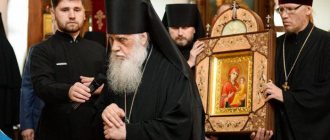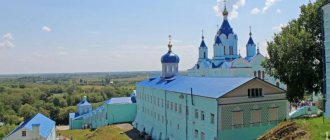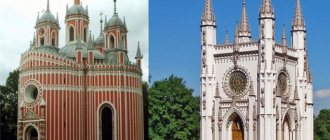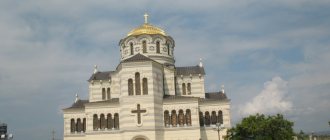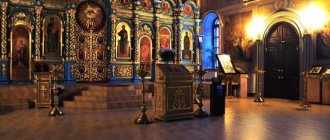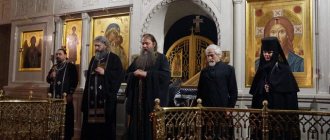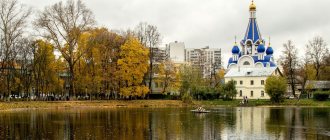The Church of the Conception of Righteous Anna, “in the Corner ,” was mentioned for the first time in 1493. The temple was probably built earlier. Historians believe that there is every reason to say that the building appeared during the reign of Prince Vasily II, and his wife wanted to build the Conception Church.
In the chronicle, the church is mentioned in connection with the fire that then swept through all of Moscow. The elements also destroyed the wooden shrine.
After the fire, the temple was restored, but in 1547 it suffered the same fate. By decree of Ivan the Terrible, the church was partially restored to its original appearance.
Story
At Kirochnaya Street, building 8 B, there is a building topped with a turret . This is the Lutheran Church of St. Anne - Annenkirche. The building once gave its name to the street itself, from the word “kirkha”.
It was erected from 1775 to 1779 on the site of an old wooden building under the direction of the architect Yuri Felten, known for such works as Palace Square, the interiors of the Winter Palace and the lattice of the Summer Garden. He became one of the first parishioners, along with Carl Faberge, Karl Bryullov, Peter Lesgaft.
During the 19th century, St. Anne's Church became a spiritual home for thousands of parishioners , many of whom were Russified Germans, Danes, and Dutch. A hospital and shelters operated under her. But after the revolution of 1917, along with the Lutheran faith, Annenkirche also suffered.
In 1935 the temple was closed. And four years later, the Spartak cinema was unexpectedly organized . Native St. Petersburg residents know that back in the 80s this place was one of the few where Soviet citizens could see masterpieces of world cinema that had long since been released from all-Union distribution.
In the 90s, a rock club was opened in the building. Alternative music sounded within its walls, there was a casino, a bar and even a tattoo parlor.
An attempt to revive the Lutheran Church took place between 1992 and 1997. In parallel with film screenings, church services were also held here. In 2002, they decided to break this strange neighborhood by transferring the temple to the church.
But Annenkirche had to endure a new test - a severe fire that destroyed everything except the walls. Now the church, classified as a monument of federal significance, is being restored and gradually transformed. Divine services are held there .
A special cultural space is created within its burnt-out walls:
- people of creative professions gather
- exhibitions, performances, organ concerts, lectures are organized
- operas sound
CONCEPTION OF THE RIGHTEOUS ANNA OF THE HOLY VIRGIN NUNNY MONASTERY
Archival materials on the history of earthenware from the 17th to 18th centuries. until now time were not the subject of special study, and therefore information on this period is fragmentary.
When creating Z. m. at the beginning. 80s XVI century, when, according to the grant of 1623, he received the estate, the documents for the ownership of the monastery remained with the Alexievsky Monastery in Chertolye. When the Alexievsky Monastery was transferred to the White City, his lands remained with him (except for the village of Nizhneye received by the spiritual prince Mikhail Andreevich with lands; by 1560 they included the village of Tatarinovskoye in the Manatin camp of the Moscow district - ARG: AMMS. P. 159 -160). The issue of the lack of agricultural land in the Z. m. in the 17th century. will remain unresolved. Of the land holdings, Z. m. had only an urban settlement. The first mention of it as a settlement of the Alexievsky Monastery in the list of possessions not included in the oprichnina may refer specifically to the settlement on Ostozhenka: “The command and at the Posad took streets into the oprichnina from the Moscow River: Chertolskaya Street and from the Semchinsky village and to all the way, and Arbatskaya street on both sides and with Sivtsov Enemy and to Dorogomilovsky alley, and half of the street to Nikitskaya street, from the city going on the left side and to all the way, beside the Novinsky monastery and the Savinsky monastery settlements and beside the Dorogomilovsky settlements and to the New Devich monastery and Alekseevsky monastery settlement" (PSRL. T. 13. P. 395, under 7073 [1565]).
Pectoral cross-reliquary. XV century Pectoral cross-reliquary. XV century According to the charter of 1623, in the 80s. XVI century Z. m. received a friend (see: Smirnov. 1884. P. 16); the same document describes the amounts of various extraditions in the 1920s. XVII century (Ibid. p. 18). The abbess and the beavers living on the monastery land were also given the right to brew beer, wine and honey for their own consumption (“beer turnout”). In 1677, documents record the exact amounts of distributions to the clergy of the Z. m. “table and dinner and prayer money,” while the nuns, led by the abbess of the Z. m., received a salary in supplies. A charter of 1623 approved the rights of Z. m. to the courtyards surrounding it and the duties of their inhabitants: “Yes, they have a settlement on the monastery land, and the peasants live in it, and she [the abbess] receives from those peasants a rent for the land from the monastery fathoms of ten money each... And don’t give those of our people any taxes, and with tax people with sots and tens, don’t drag in anything in any way and in estimates” (Ibid. P. 19). When, according to the Council Code of 1649, only state officials remained in Moscow. settlement, employees began to settle on the land of Z. m., paying for the rent of land and buildings: in the census of 1665-1667. (46 households in total) a large group of Sloboda tenants was noted from among the clerks of the Rank and Money Orders, the Red Court and the Armory Chamber, as well as artisans, clergy and clergy, grooms and archers, stewards, boyar children and tenants. The charter of 1623 determined the procedure for judicial proceedings. In Z. m. and its settlement, the abbess had the right of trial, “against murder and robbery and red-handed tatba.” Litigations between city or volost people and monastery people were dealt with by clerks. In cases of litigation between the abbess and the sisters or between clergy and clergy, the right of court passed to the patriarch. The claim against the abbess and the sisters or against their servants and people of the monastery settlement was dealt with personally by the tsar or the one whom he ordered. The benefits of Mikhail Feodorovich's charter were later confirmed by Tsars Alexei Mikhailovich and Feodor Alekseevich.
In the 19th century In the monastery sacristy, contributions to the collection of church utensils and books made by the first kings of the Romanov dynasty were kept. Among them are early printed Apostles on boards covered with leather, with a signature on behalf of Tsar Mikhail Feodorovich dated April 5. 7146 [1638]; The Four Gospels of 7135 [1627] on boards covered with blue velvet, with dedicatory inscriptions of 1642; Pentecost and the Colored Triodion, donated by Tsar Alexei Mikhailovich in 1670. Tsar Alexei Mikhailovich ordered (1653) a silver (gilded) altar cross-reliquary of embossed work, with precious stones, on the reverse side of which there were 20 particles. St. relics.
Relatively few royal appearances in Z. m. are recorded (Tsar Alexei Mikhailovich visited Z. m. on March 22, 1666, April 24, 1668, May 21, 1674, in April 1675), but a certain connection can be traced between these visits and visits on the days of celebration in memory of St. Alexia, Metropolitan Moskovsky, in maiden mon-ri, located above the Kremlin on the river. Moscow (for example, in 1674, “May the 21st day on Thursday... I deigned to go from the village of Khorosheva to Moscow and was in the monasteries in Alekseevsky, in Zachateisky, in the Novo-Devichi monastery”). Even fewer visits to Tsar Feodor Alekseevich are mentioned, and they are associated with tradition. dates of trips to the monasteries (on cheese week, February 9, and “on Tuesday of Myrrh-bearing week,” April 16).
From the features of worship in the 17th century. arrival is noted in the 80-90s. on the temple holidays of the Conception of Rights. Anna the Pres. Mother of God and Nativity of the Most Holy. The Mother of God in Z. m. the bishop (he was sent “when the Government congressed in Moscow”) or more often the abbot of the monastery (usually Sretensky).
Changes in government and church life in Russia during the imperial era. Peter I affected Z. m., the economic state of which at the turn of the 17th and 18th centuries. has become unenviable. The main source of existence was the tsar’s abuse, which was granted only to the abbess and sisters, but not to the church clergy (“...do not give abuse to the priest and the clergy, but the breadwinner is the clergyman of the parochial people” - Rate Book [7] 207 // Zabelin. 1884. Stb. 487). In the parish of Z. m. there were then only 28 households from the previous 150, soon their number was reduced to 24. By the royal decree of July 11, 1700, all of the land of Z. m. was replaced by lands in Ryazhsk from the registered estates of the okolnichy prince. S. R. Pozharsky. The right to the lands of the monastic settlement was also reserved for Z. m. (Ibid. Stb. 487), but the share of revenues from its courtyards continued to fall. The petition of 1716 describes the situation of Z. m. as the most disastrous: “... there is nothing to pay, the monastery is the most meager and we feed on worldly donations; But the equivalent of your royal monetary salary has not been determined for us and we are in great poverty and can never pay such a premium; and no matter how much they beat us on the right, we have nothing to pay,” wrote Abbess Anna (Larionova) with her sisters (Ibid. Stb. 731), explaining this by the fact that the residents “from melt water, and from standstill, and from fires They went and left their yards, and some of the rest live and they pay bridge money from that land and put up a place, but in previous years there were no payments from them...” From the beginning XVIII century Stone buildings began to be built on plots owned by Z. m.; Some of them have been preserved in a rebuilt form: the Kireyevsky chambers (Ostozhenka St., 19, building 2), the Bukhvostov house (2nd Zachatievsky lane, 5/23), the Okulova house (3rd Zachatievsky lane, 5).
Bone rosary. XVII–XVIII centuries
Bone rosary. XVII–XVIII centuries After the decree on the possibility of buying and selling monastery lands, the difficulties worsened: merchants, officials, and guild workers who became rich began to buy up empty lands. Z. m. lost the communal charter: the nuns lived on salaries from the treasury, on family capital or funds from benefactors; the so-called Belitsa, most of them from noble families, who lived, among other things, on the proceeds from the sale of handicrafts. Among the handicrafts, spinning was widespread (in 1722, craftswomen were sent from the spinning yard with tools to teach nuns the art of spinning), knitting, lace weaving, sewing ceremonial dresses and gold embroidery. Already towards the end. 20s XVIII century and especially during the reign of Anna Ioannovna (1730-1740), the state of affairs improved; the Moscow census of 1738 records 109 households on the lands of Z. m.
In 1763, according to the inventory of ensign F. Pavlov (RGADA. F. 280. Inventory 3. D. 191), on the monastery lands there were 68 houses, a cherry orchard, 2 vegetable gardens and a wasteland along the river, which together gave 115 rubles. 60 kopeck rent per year. The inventory lists numerous nuns: abbot. Alexandra (“from the Great Russian priest’s wife. She has no handicraft”), treasurer (from belitsa), 30 nuns (5 churchwomen, 4 psalmists, 3 abbess guides, 18 privates, most of them elderly), 35 belitsa ukaznitsa, 4 appointed for tonsure, 14 living without a decree. Among the whites, many were from noble families known in Moscow. All of them, as well as the elderly and crippled soldiers who lived in the almshouse established under Z. M. by order of the Emperor. Peter I, received a salary from the monastery in money and bread. 10 clergy and clergy are named (4 priests, 3 deacons, sexton, sexton, watchman). According to the inventory of 1763, many vestments and church fabrics were stored in the sacristy (8 pairs of marching and 28 festive vestments, 4 curtains for the royal gates and 5 vestments for the throne and altar, 12 altar cloths, 13 everyday and 56 festive vestments, etc.). Most of them are made of expensive colored fabrics, generously embroidered with silver and gold thread and are probably the work of the nuns of Z. m. The book depository had approx. 50 ch. arr. liturgical books.
In 1764, with the introduction of the Regulations on the States, Z. m. was defined as a 3-class non-dormitory and was deprived of almost all property in the city. So, restoring the dilapidated fence of Z. m. in 1772, abbot. Izmaragda was forced to ask the spiritual consistory to allow the dismantling of the dilapidated church, closed after the plague, to be dismantled. St. Nicholas the Wonderworker in Kievtsy (area of modern Prechistenskaya embankment) to obtain materials for construction. The land remaining after the church was dismantled in 1788 at the request of the abbot. Amphilogia was approved for permanent ownership of the land, was used for timber rafting, and later was rented out. The stone construction and improvement of the monastery were carried out mainly at the expense of wealthy benefactors.
With the beginning of the reign of the Emperor. Paul I, salaries for bishops' houses and monasteries were increased; They were endowed with mills, fisheries, lands and farmland from government quitrent articles. In 1796, Z. M. received, along with other monasteries, 32 dessiatines. land in the dachas of the village Solomykovo Bronnitsky district In 1798, Emperor. decree at the request of the abbot. Dorimedonts (Protopopova) The Moscow State Chamber took over the ownership of Z. m. fishing from the mouth of the river. Zhukovka down the river. Moscow is 3 miles from the Lutskov dachas (Z.M. used it himself, and began renting it out in 1830); at the same time was granted under the village. Vakarine on the river. Istra mill (rented). During this period, there were more than 100 nuns in Z. m., headed by abbots. Dorimedontoy; The reconstruction of the cathedral complex was completed.
Church of the Descent of the Holy Spirit. Photo. 2008
Church of the Descent of the Holy Spirit. Photo. 2008. The invasion of Napoleon in 1812 caused significant damage to the Z. m. Dorimedonta and her sisters remained in the monastery. From 2 to 4 September the gates of Z. m. were closed; priest Emilian Egorov served the liturgy daily. 4 Sep. St. the gates were broken open and the monastery was set on fire. The sisters found protection behind the Crimean Bridge, and three days later they returned to the monastery, which the French had forbidden to rob. 8 Sep. The all-night vigil was served, the next day - the liturgy on the unexposed altar in the chapel of St. Alexia. In addition to the monastic ones, approx. people lived in the church. 200 people fleeing the fire and the enemy. After the liberation of Moscow, Z. m. received funds for restoration.
The charter of a charitable institution on a salary to the c. In honor of the Descent of the Holy Spirit, a supernumerary priest was appointed, as well as a clergywoman and several choir members. Poor monastery sisters worked in the almshouse, using the heated cell and the monastery meal, and for linen, clothes, etc. received a salary and were allowed to work for themselves in their free time.
The state of affairs in Z. m. by mid. XIX century reflects the Abbot's report. Kaleria (Tail) for 1821-1867. During these years, the number of nuns doubled, to 173, and income increased 10 times; in churches and other monastery buildings, iconostases and paintings were repeatedly renewed; Church bells were significantly increased. Besides c. After the Descent of the Holy Spirit, a large two-story stone building was built (1844): on the upper floor there were cells, and on the lower floor there was a common meal, kitchen, etc., the monastery fence and household services were renewed. In Zvenigorodsky district. was allocated at the request of His Eminence 150 dessiatines from state dachas. woods for heating. The monastery provided temporary shelter to pilgrims, supplied them with food from the common meal, and the poor also ate from it. Z. M. was actively involved in charity work (donations for the benefit of Syrian Christians, for the maintenance of officials of the spiritual consistory, for the maintenance of religious educational institutions, etc.).
Since 1881, under abbot. Valentina, actions were taken to restore the communal way of life. K con. XIX century Z. M. was in the 3rd grade. There were up to 180 nuns in the state. They were released from the Moscow province for maintenance. treasury for the salary of the abbess with monastics, clergy and clergy - 200 rubles. 28 kopecks, for church needs - 8 rubles. 55 k., for the maintenance of the sacristy - 57 rubles. 12 k., for hiring servants - 115 rubles.
Abbess Z.M. made a lot of efforts to revive the communal way of life and update the monastery. Maria (Box). In addition to the kvass factory and bakery, the new refectory building housed icon painting, handicraft and candle workshops. The sisters were engaged in gold-embroidery and white-embroidery needlework, embroidered shrouds and icons with silk, made flowers to decorate churches, etc. The monastery had a 2-grade school with free lunch, a reading room for sisters, a library, a hospital, and an almshouse for sisters. In 1910, the Aksakovsky orphanage for girls, which was located at the Filaretovsky School, was transferred to the old refectory building. Existed from the beginning. XX century The parochial school was converted into a 2-grade school. In 1914, the monastery opened a shelter for the children of soldiers who died in the First World War.
In 1910, the abbot's request was granted. Mary about the establishment of a monastery courtyard on lands in the area of the village. Barvikha Zvenigorodsky district Abbot's cells, a house for sisters, a refectory, a hospital and a school for peasant children, as well as utility buildings were built. In 1911, a church was erected on the courtyard.
By 1918, there were 375 nuns in Z. m.
Restoration of facades
annenkirche_official
dasha_cloud
ks.anreevna
restikss
leno__99
samakat1909
Since 2009, the temple, which by this time had remained without a roof, in a state of complete ruin, was transferred to the jurisdiction of the city by decision of Governor Valentina Matvienko. This made it possible to restore the external facades of the temple and repair the roof. Now visitors to the Annenkirche, and just passersby, see the historical appearance of the Church of St. Anne on Kirochnaya Street.
A new stage of revival is the restoration of interior interiors. covered with peeling , burnt plaster, which resemble an apocalyptic picture, are popular with young people for their atmosphere. And yet they require large material investments, just like the restoration of the cross on the bell tower.
Church of St. Righteous Anna, Kovrov
SCHEDULE :
5th Week after Pentecost
| MONDAY July 19 | 9:00 Prayer service to the Ethereal Heavenly Forces (Guardian Angels, Archangel Michael, Angels and Archangels), Memorial Service |
| TUESDAY July 20 | 9:00 Prayer is right. Joachim and Anna, Requiem Service |
| WEDNESDAY July 21 Appearance of the icon of the Most Holy Theotokos in the city of Kazan (1579). | 7:00 Matins, Hours, LITURGY |
| THURSDAY July 22 | 9:00 Prayer service to St. Afanasy, bishop Kovrovsky, Memorial Service |
| FRIDAY July 23 | 9:00 Prayer service to the Life-giving Cross of the Lord, Panikhida |
| SATURDAY July 24 Equal. Olga, lead. Princess of Russia, at the Holy Baptism of Helena (969). | 7:00 Matins, Hours, LITURGY 16:00 Akathist before the icon “ Inexhaustible Chalice ” (about those suffering from the disease of drunkenness and drug addiction) 17:00 All-night vigil |
| SUNDAY July 25th 5th Sunday after Pentecost.Mc. Proclus and Ilaria (II century). | 6:30 Litia, Hours, Early LITURGY, Prayer service 8:30 Hours, Late LITURGY |
6th Week after Pentecost
| MONDAY July 26 | 9:00 Prayer service to the Ethereal Heavenly Forces (Guardian Angels, Archangel Michael, Angels and Archangels), Memorial Service |
| TUESDAY July 27 | 9:00 Prayer is right. Joachim and Anna, Requiem Service |
| WEDNESDAY July 28 Equal. led Prince Vladimir, in Holy Baptism of Vasily (1015). | 7:00 Matins, Hours, LITURGY |
| THURSDAY July 29 | 9:00 Prayer service to St. Athanasius, bishop Kovrovsky, Requiem service |
| FRIDAY July 30 | 9:00 Prayer service to the Life-giving Cross of the Lord, Panikhida |
| SATURDAY July 31st Martyr. Emilian (363). | 7:00 Matins, Hours, LITURGY 16:00 Prayer service with Akathist before the icon of the Mother of God, called “ The Tsarina of All ” (this icon is addressed in case of cancer) 17:00 All-night vigil |
| SUNDAY August 1st Week 6 after Pentecost. Finding the relics of St. Seraphim of Sarov, miracle worker (1903). | 6:30 Litia, Hours, Early LITURGY, Prayer service 8:30 Hours, Late LITURGY |
7th Week after Pentecost
| MONDAY August 2 Prophet Elijah ( IX century BC). | 7:00 Matins, Hours, LITURGY |
| TUESDAY August 3 | 9:00 Prayer is right. Joachim and Anna, Requiem Service |
| WEDNESDAY 4 August | 9:00 Prayer service to the Mother of God, Requiem service |
| THURSDAY 5 August | 9:00 Prayer service to St. Athanasius, bishop Kovrovsky, Requiem service |
| FRIDAY 6 August | 9:00 Prayer service to the Life-giving Cross of the Lord, Requiem service 17:00 All-night vigil with lithium |
| SATURDAY AUGUST 7 Dormition of rights. Anna, mother of the Blessed Virgin Mary. PARENTAL HOLIDAY | 7:00 Prayer service, Litia, Hours, LITURGY 16:00 Akathist before the icon “ Inexhaustible Chalice ” (about those suffering from the disease of drunkenness and drug addiction) 17:00 All-night vigil |
| SUNDAY August 8th 7th Sunday after Pentecost. Hermolai, Hermippus and Hermocrates, priests of Nicodemus (c. 305). | 6:30 Litia, Hours, Early LITURGY, Prayer service 8:30 Hours, Late LITURGY |
Architecture
The church on Kirochnaya Street is not the first Lutheran church built in the northern capital. Initially, Annenkirche was built of wood and was located in the Peter and Paul Fortress. The year of construction was 1704. Then the church was moved first to Mytny Dvor, and then to its modern address, on Kirochnaya Street, which in those days was called the 5th line of the Liteinaya part.
The church of St. Anne, built in stone, was consecrated in 1779 . The building was designed by architect Yuri Felten.
It has its own “zest”: the building has two equivalent facades facing different streets: Kirochnaya and Furshtatskaya. The appearance of the temple fits into the canons of that time. It is decorated with Ionic columns and a hexagonal round tower crowning the building.
It's beautiful here, isn't it?
Not really
A notable detail of the Annenkirche interior is the Ionic colonnade . It supports the vault of a vast hall, which can simultaneously accommodate about one and a half thousand visitors. But the most important decoration of this place is the large altar painting “The Ascension of Christ” , made by E. Lipgart.
History[edit]
The temple began to be built in memory of the deceased Kovrov resident, whose name was Anna. First, her widowed husband S.I. Khokhlov. decided to build a chapel. Then the decision was made to build a temple.
In January 2010, the bishop's blessing for construction was received. The city administration has allocated a place - a square located at the intersection of the street. Oleg Koshevoy and Griboyedov. There was no temple in this densely populated area. Pastoral care was entrusted to Priest Mikhail Buntilov. The temple was built solely on voluntary donations.
The design of the temple was developed by the diocesan architect Alexander Nikolaevich Trofimov.
On November 12, 2011, the rite of consecration of the foundation stone for the foundation of the future temple was performed, headed by the abbot of the Nativity of the Mother of God Monastery in the city of Vladimir, Archimandrite Nil (Sychev).
In commemoration of many labors, the temple-created document and icon of the Mother of God were presented to the church ktitor S.I. Khokhlova.
An icon of St. Righteous Anna was painted especially for the temple. Do not confuse this image with the image of the Mother of God with Jesus. Righteous Anna holds a baby in her arms, but not a boy, but a girl, Mary, the future Mother of God.
Annenkirche now
The creation of a modern cultural space in Annenkirch began in 2014. Several artists proposed organizing an exhibition of contemporary art within the walls of the church . Soon this unusual idea received an equally interesting embodiment. It was an exhibition called "Fear" , dedicated to human fears.
In the ominous and mysterious atmosphere of the half-burnt church, the following were built:
- labyrinths
- installations
- plastic studies
- sound and light traps
There was even a special smell of fear and anxiety created by perfumer Nikolai Eremenko.
Artists, photographers, sculptors, and musicians worked on the exhibition. And all for the sake of one goal - to look into the depths of consciousness, to try to comprehend the features of a person’s inner world. And at the same time, give visitors the opportunity to challenge themselves through viewing frank stories.
Events
Currently, Annenkirche is one of the cultural centers of the city on the Neva . It regularly and with real hospitality opens its doors to talented, creative people recognized in the world of art or taking their first steps in this field. Every month, dozens of events are held , which are attended by up to 10 thousand people per month.
Residents and guests of St. Petersburg have already visited:
- performances “The Cherry Orchard” and “Tesla. Living illusions", "PLAY" and "Catcher in the Rye"
- concerts “Autumn leaves”, “Classics under the moonlight”, “Journey to the Silver Age”, “Piano Dreams”, Cho Morale “Attic” and many other musical events
- Science Fest, dedicated to the direction of Science & Media Art
- exhibitions “Loops” by Andrey Olenev, “After the Icon”, “Behold the Man” by Anatoly Shumkin, “Imaginary Stained Glass” by Anastasia Avraleva
- Christmas market with the indispensable attributes of this event: folk musical motifs, gifts for relatives and friends, the spirit of Christmas and a warm festive atmosphere
This list is far from complete and will expand in the future. Many events are held on a charitable basis. Musicians give free concerts within the walls of the Annenkirche, and the funds raised are used to restore the temple.
Some events take place regularly, according to a set schedule:
- English speaking club meetings
- meaningful film screenings
- educational lectures on religion, psychology, history
- course "Fundamentals of the Christian Faith"
- Directing course "Annenkirche Cinema Course"
- chamber concerts by candlelight, where you can enjoy enchanting music and a soulful atmosphere for a donation
The Lutheran Church remains active and services are ongoing. Masses are held in English and Russian.
In contact with
vk.com/annenkirche
instagram.com/annenkirche_official/
facebook.com/annenkirche/

